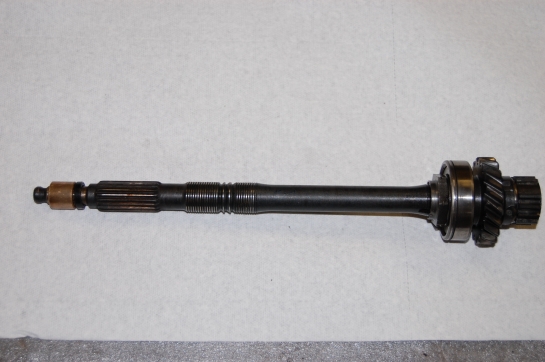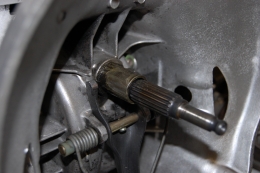Treat
your transmission well
For many
years now, the production of transmission has been discontinued. Spare
parts are limited to a few bearings, which makes it hard to rebuild a
transmission. The only way is to salvage core returns, which mostly
show the same problem as your dead transmission. So finding good parts
from returned transmissions is getting harder with the higher mileage
these boxes have seen. Already, the ratio is about 50%, meaning, that
it takes approximately two transmissions to salvage, to gain one good
unit. So treat your transmission well and don't throw it away when it
is defective. Parts of it might help keeping another 2CV going in the
future!
Things
you could do to extend the lifetime of your transmission
Change
the oil regularly after about 15000 km
The transmission needs 80W90 Hypoid oil. Don't use synthetic oil.
This has caused problems in the past. Just stick with regular oil of
the right weight and very important, the oil must be for "hypoid"
transmissions and differentials. In many vehicles, the transmission
and the differential are separate units. The pressure between the
gears in a regular transmission without a differential built in is
normal. So regular gear oil will do the job here. In the differential
however, the pressure between the gears is extremely high. In regular
gear-oil, the molecules would just break apart under his pressure.
This is why the oil for the differential is of a higher grade.
In the 2CV transmission, the differential is integrated. Both sides
in the box, gears and differential share the same oil. So make sure
that you use the right oil.
Change the transmission oil with every second oil change for the
engine. Drive the car to get the oil up to temperature and drain
engine oil and transmission fluid together. To drain the transmission
fluid, just remove the drain plug on the underside. Allow it plenty of
time to drain. Check the drain plug magnet for metal particles. Don't
be shocked, there will always be some metal powder sticking to the
magnet in the plug. The "cap" on the drain plug may get up
to half an inch high. If it is more, or solid parts, like chipped off
parts of gear teeth, it is highly recommended to have the transmission
inspected and rebuilt.
To refill the oil, put the cleaned drain plug back in and pull it
tight. Then open the plug on the passenger side of the transmission.
Now fill a quart of transmission fluid trough the hole. There is no
dipstick to measure the oil level. Once the oil starts running out the
side hole, the filling process is finished. Put the plug back in and
tighten it.
Don't
shift too rapidly
For shifting, both gears have to turn at the same speed before the
gears can be engaged. This is the job of the synchro-rings. When you
shift gears, you will feel a little resistance in the shifting lever,
just before the gears engage. This is the synchro-ring, retarding or
accelerating the other shaft to the same speed. Once the speed is
equal, the gears engage. This synchronization process causes wear on
the synchro-rings.
You can control the wear by the way you shift gears. A very sportive,
fast gear jamming way of engaging gears, leads to a high wear on the
synchro-rings. Once the synchro-rings are worn, this is it. They
cannot be replaced, and chances are that parts from other salvaged
transmissions show the same wear. So subsequently, the transmission is
doomed.
To prevent this, watch the way you shift gears. Don't force the gears
in rapidly; applying gentle pressure, give the synchro-ring some time
to synchronize the speeds. This way you can significantly minimize the
wear on the synchro-rings.
Mount
the motor correctly
A very prominent reason for the main input shaft to wear out is an
improper mount of the motor. When you look at the front of the
transmission, you will find the four mounting points for the motor
bolts. The upper left and the lower right of these mounting points
have steel sleeves to center the motor versus the transmission.
Corrosion makes these sleeves to seize on the engine mounting bolts.
When the motor is removed, the sleeves sometimes come out of the
transmission. If they are not put back into the transmission, the
alignment between the motor and the transmission is off. This pushes
the main input shaft against the steel sleeve and makes it wear out in
a very short time. So before you mount the engine, better double check
if the alignment sleeves are in place.

Make
sure the main input shaft bearings are good
The main input shaft transmits the power from the engine via the
clutch into the transmission. The shaft is quite long. Its' front end
goes through the clutch disk, its' rear end transmits the power into
the upper shaft inside the gearbox. The shaft has a bearing on each
end. The rear main input shaft bearing is hidden inside the
transmission between the differential and the gearbox. With the
transmission inside the car, the only indication for this bearing to
be bad is a grinding noise from the transmission. When the engine is
removed, you can test by wiggling on the shaft. If the shaft has too
much play sideways, up and down, the bearing might be bad.
Usually underestimated is the front bearing of the main input shaft,
which is the pilot bearing inside the rear end of the
crankshaft. In the early models, this bearing was a needle roller
bearing. All the later models had just a bronze bushing for the
bearing. When the engine is mounted, the main input shaft is inserted
through the clutch disk into the pilot bearing. To avoid clutch dust,
or other dirt, to get inside the bearing, there is a rubber seal on
the back of the crankshaft. When this bearing goes bad, you will hear
a screeching noise when the clutch pedal is pressed down all the way.
Only then the speed of the crankshaft and the main input shaft is
different. When the clutch pedal is released, the noise goes away. If
that is the case, the pilot bearing MUST be replaced as soon as
possible.
If either one of these bearings wear out, the shaft will have some
play. This has a devastating result. The main input shaft has no seal
to keep the oil inside the transmission. Instead, there is a spiral -
like a thread- cut into the shaft, where it goes trough the clutch
bell housing. When the shaft turns, this spiral pumps the oil back
into the transmission. If the shaft has play because of a worn
bearing, the tips of this thread like spiral wear out when they touch
the steel sleeve inside the clutch bell housing. Once this happens,
the gap that opens up, allows the oil to squeeze by the shaft into the
clutch bell housing. At first, the oil soaks the clutch - which leads
to a scattering clutch. Then the oil flies off the flywheel. On each
side of the clutch bell housing is an opening. The oil goes trough
these openings right onto the brake rotors. Subsequently the brakes
are shut. As for the shaft, once the thread is damaged, the shaft is
destroyed, leaving this transmission as a parts donor.



In many
cases when you remove the engine, you will find the seal for the pilot
bearing missing or damaged. I've seen the seal fall out of the
crankshaft very often when the motor is removed. This means that the
bearing might already be damaged. So the rule should be to replace the
pilot bearing every time the clutch is replaced. The bearing and the
seal are inexpensive, and quite easy to replace (if bronze bushing is
used). To pull the pilot bearing, just use a ½ inch tap to cut a
thread into the bearing. The inside of the bushing is 12mm, the
outside of the tap is just over 13mm. So if the bearing isn't worn too
much, you can cut a nice thread into the inside of the bushing.
Continue cutting until the tap hits the inside of the crankshaft. From
now on, every turn of the tap will pull out the bushing a little
farther. Continue turning until the bushing is out. Then clean the
inside of the crankshaft and insert the new bushing all the way. To
drive the new bushing back into the crankshaft, use a socket, or a pin
that fits into the hole on the flywheel. Fimally insert the new seal.
Note that the flywheel doesn't need to be removed, only the scrap
engine that I had handy for the photo didn't have the flywheel on. 
|